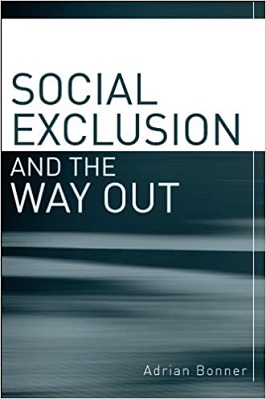
| Book Title | Social Exclusion And The Way Out |
| Book Author | Adrian Bonner |
| Total Pages | 286 |
| Book Views | |
| Language | English |
| Book Download | PDF Direct Download Link |
| Get Hardcover | Click for Hard Similar Copy from Amazon |
SOCIAL EXCLUSION AND THE WAY OUT
An individual and community response to human social dysfunction – Adrian Bonner
SOCIAL EXCLUSION AND THE WAY OUT
Book PREFACE
Social Exclusion and the Way Out is an attempt to provide a critical appraisal of the complex nature of social exclusion, which has not changed, in many ways, since the nineteenth-century philosophers began to diagnose problems of the ‘deserving and undeserving poor.
In 2006 poverty still exists but, in the analysis of the social dimensions of poverty and social exclusion, it is essential to focus on the nature of human dysfunction.
Irrespective of an individual’s income and wealth or poverty, the person’s perception of their social identity and quality of life will be significant determinants of their response to their social situation.
One of the long-lasting objectives of The Salvation Army’s Social Services is to work with people where they are and to help them develop a sense of meaning and belonging.
Hopefully, a greater understanding of individual functioning and the underlying issues of mental health, illness, and the pervasive problems of alcohol dependency will provide some insight into new ways of identifying individual needs and help to inspire new interventions to support the vulnerable members of the community.
WHAT IS SOCIAL EXCLUSION?
Early definitions of social exclusion were quite broad and described the consequences of the associated problems of unemployment, poor skills, low incomes, poor housing, high crime, bad health, and family breakdown. The UK government’s Department of Culture, Media and Sport used operational definitions such as:
Social exclusion takes many forms. It can be direct or indirect and can embrace both groups and individuals. Exclusion also has a geographical dimension embracing rural, urban, and suburban areas alike (DCMS 1999).
The government’s definition of social exclusion was extended in 2001 to include:
Social exclusion is something that can happen to anyone. But some people are significantly more at risk than others. Research has found that people with certain backgrounds and experiences are disproportionately likely to suffer social exclusion.
The key risk factors include low income; family conflict; being in care; school problems; being an ex-prisoner; being from an ethnic minority; living in a deprived neighbourhood in urban and rural areas; mental health problems, age, and disability (DfES 2005).
Although UK government definitions have been broadened during recent years, social exclusion is still couched in anti-poverty work. Percy-Smith (2000) has argued against the narrowing of definitions to poverty and spatial issues, she defines seven ‘dimensions of social exclusion:
- Economic (e.g. long-term unemployment; workless households; income poverty).
- Social (e.g. homelessness; crime; disaffected youth).
- Political (e.g. disempowerment; lack of political rights; alienation from/lack of confidence in political processes).
- Neighbourhood (e.g. decaying housing stock; environmental degradation).
To read more about the Social Exclusion And The Way Out book Click the download button below to get it for free
Report broken link
Support this Website
Click here to join our Telegram group for new Books